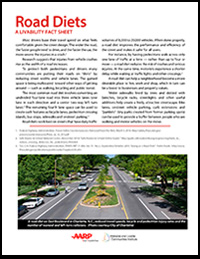AARP Livability Fact Sheet - Road Diets
Supersized, multilane roadways are fast-moving, unattractive and often impossible to cross. Learn how the streets near you can slim down, spruce up and become safer for all users
Most drivers base their travel speed on what feels comfortable given the street design. The wider the road, the faster people tend to drive and, the faster the car, the more severe the injuries resulting from a crash.
Research suggests that injuries from vehicle crashes rise as the width of a road increases.
To protect both pedestrians and drivers many communities are putting their roads on "diets" by reducing street widths and vehicle lanes. The gained space is being reallocated toward other ways of getting around — such as walking, bicycling and public transit.
Key Points
The most common road diet involves converting an undivided four-lane road into three vehicle lanes (one lane in each direction and a center two-way left-turn lane). The remaining fourth lane space can be used to create such features as bicycle lanes, pedestrian crossing islands, bus stops, sidewalks and on-street parking.
The authors address various myths about road diets. Here are a few:
- Myth: "Road diets are bad for business."
Road diets actually increase and enhance business activity by reducing traffic speeds (which helps motorists notice the shops, eateries and businesses they’re driving alongside) and by accommodating pedestrians and bicyclists (who tend to spend more money at local businesses than drivers do).
- Myth: "People don't like road diets.”"
The Electric Avenue road diet in Lewistown, Pa., was opposed by 95 percent of residents when it was first proposed; after completion, nearly 95 percent of residents are supportive of the changes.
Success stories are provided from Florida (Orlando), Washington (Seattle) and Georgia (Athens):
- After narrowing a 1.5-mile section of Edgewater Drive in the College Park neighborhood of Orlando, vehicle crashes decreased by 34 percent and related injuries declined by 68 percent.
- After a road diet was completed on a 1.2-mile section of Seattle's Stone Way North, crash data showed an overall decrease of 14 percent, injury crashes dropped by 33 percent and angle crashes dropped by 56 percent. Bicycle volume increased 35 percent yet the bicycle crash rate showed no increase. Pedestrian crashes decreased 80 percent.
- A road diet conversion on an Athens arterial road with 20,000 vehicles daily resulted in crashes dropping 53 percent in general and 60 percent at locations without traffic signals.
How to Use
Because the fact sheets in the Livability series are only four pages each, the materials are quick and easy to read online or to download and print for sharing.
The Road Diets fact sheet can be used by policy makers, transportation planners, community leaders and citizen activists to educate themselves and others about the neighborhood benefits of having narrower roadways.
The page "How to Get it Right" offers steps advocates and community leaders can take to encourage putting wide, unsafe roads on a diet.
Among the suggestions: Locate a pilot project on a road that carries no more than 15,000 vehicles a day and that ideally serves a downtown neighborhood or historic district with potential for reinvestment and/or economic development.
Fact sheet published Spring 2014
Stay Informed — For Free!
AARP.org/Livable
Enter a topic, name, place, etc.




